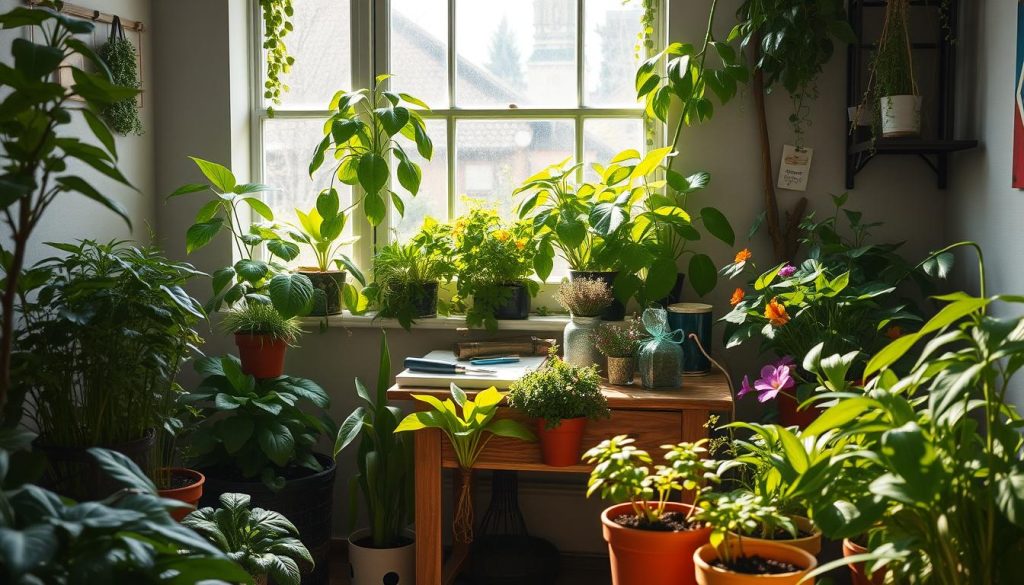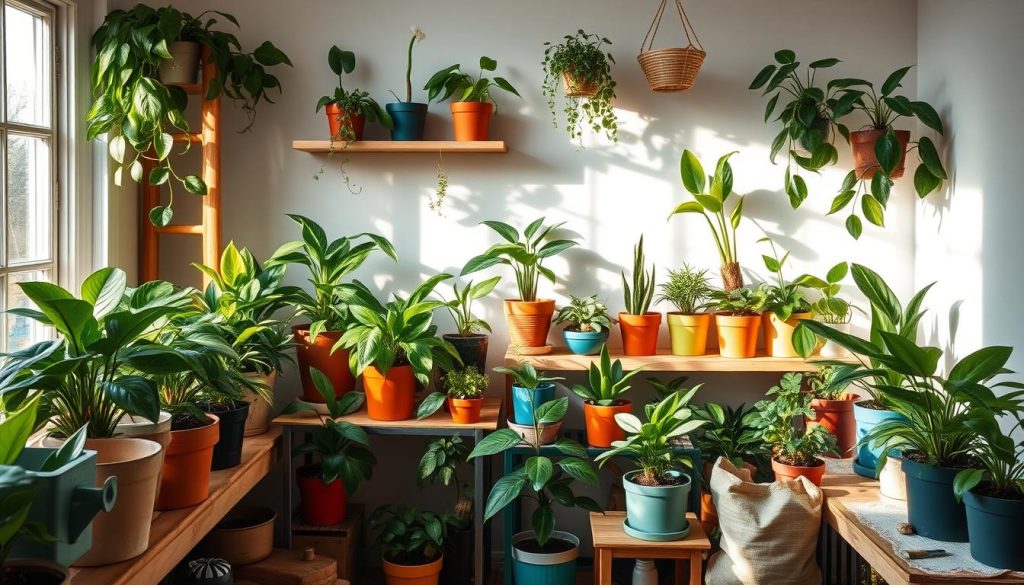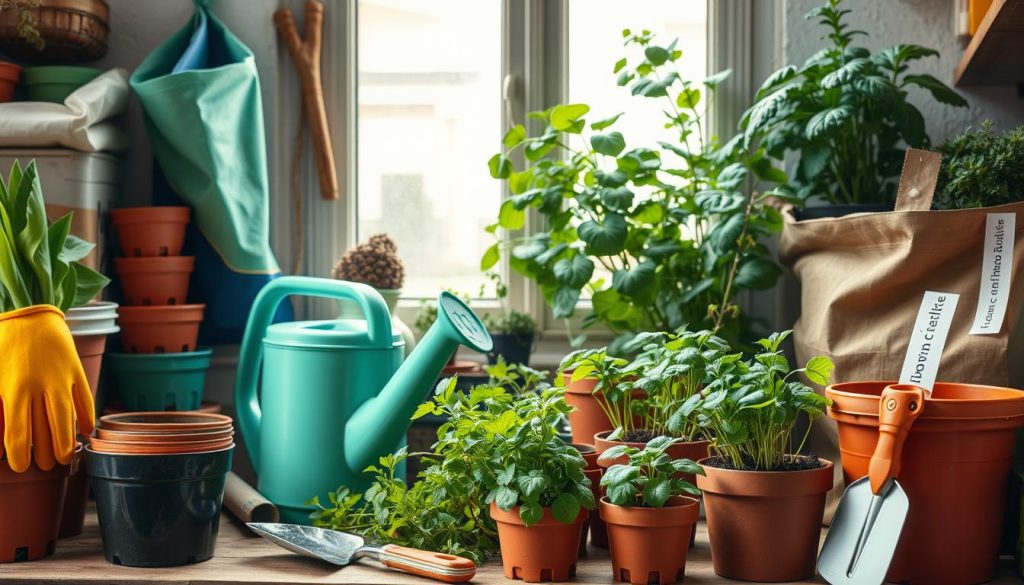I’m excited to share my love for indoor gardening with you. This guide is here to help you start. You’ll learn how to create a beautiful indoor garden with my tips. Whether you’re new or experienced, I aim to give you the essentials for success.
Starting with indoor gardening can seem tough, but it’s not. My tips will help you pick the right plants and keep your garden healthy. You’ll enjoy the benefits of better air and a prettier home.
In this guide, I’ll share my knowledge on indoor gardening. We’ll talk about choosing plants, soil, fertilizers, and controlling pests. My goal is to give you the confidence to create your own indoor paradise.
Why I Love Indoor Gardening
I love growing plants indoors. It’s great for cleaning the air, making my home look better, and feeling close to nature. With good ideas, you can make a garden that makes you happy and calm.
Some top plants for indoors are easy to care for, like snake plants and spider plants. They’re great for beginners. Here’s why they’re good for indoor gardening:
- Improved air quality
- Reduced stress and anxiety
- Enhanced aesthetic appeal
Adding indoor gardening to your life can really pay off. You’ll see the benefits and enjoy taking care of your plants.

Benefits of Growing Plants Indoors
Indoor plants can make you feel better physically and mentally. They clean the air and help you relax. The benefits are many and well-known.
Personal Experiences with Plants
My experience with indoor gardening has been amazing. It helps me relax and enjoy watching my plants grow.
Connecting with Nature at Home
Indoor gardening lets me feel connected to nature, even when I’m inside. Having plants around makes me feel more grounded and connected.
Choosing the Right Plants for Beginners
Starting with indoor gardening can feel overwhelming. There are so many plants to choose from. It’s important to pick ones that are easy to care for.
Beginners should look at plants like snake plants, spider plants, and ZZ plants. These are great for indoor gardens because they need little care.
Having the right tools is key for indoor gardening. You’ll need containers, soil, and fertilizers made for indoor plants. If you want to grow herbs, basil, mint, and cilantro are easy to start with.

Seasonal changes can impact your indoor garden. Knowing what your plants need helps keep your garden healthy all year. With the right plants and supplies, you can enjoy a beautiful indoor space.
Low-Maintenance Indoor Plants
- Snake plants
- Spider plants
- ZZ plants
Best Herbs for Indoor Gardens
- Basil
- Mint
- Cilantro
Essential Supplies for Indoor Gardening
Indoor gardening needs the right supplies for success. Quality indoor gardening essentials make a big difference. Containers, pots, soil, and fertilizers are all key for a thriving garden.
To start, you’ll need basic supplies. Here are a few must-haves:
- Containers and pots that fit your space and style
- High-quality soil and fertilizers for indoor plants
- Watering tools, like a watering can or spray bottle, for the right moisture
Using these indoor gardening hacks will help you create a lush garden. Choose supplies that meet your and your plants’ needs. Don’t be afraid to try new things.

Containers and Pots
Choose containers and pots that fit your plants well. Look for ones with good drainage to avoid waterlogged soil.
Soil and Fertilizers
Get high-quality soil and fertilizers for indoor plants. They provide the nutrients your plants need to thrive.
Watering Tools
Pick watering tools that work for you, like a watering can or spray bottle. They help you water your plants just right.
Finding the Perfect Spot for Your Indoor Garden
Finding the right spot for your indoor garden is key for your plants’ health. I think about light, temperature, and humidity when picking a spot. This way, I can make a great environment for my plants to grow well.
Assessing Light Conditions
Light is very important for indoor gardening. Plants need different amounts of light. Some, like succulents, need direct sunlight. Others, like ferns, prefer indirect light.
Knowing what your plants need helps you pick the right spot. This ensures they get the light they need to thrive.

Temperature and Humidity Requirements
Temperature and humidity are also key. Most plants like daytime temperatures between 65-75°F. Nighttime should be 5-10°F cooler. Humidity levels also matter, with some plants needing more than others.
By considering these factors, you can create a perfect spot for your plants. This leads to a beautiful indoor garden that improves your air quality.
Some plants, like spider plants and snake plants, are easy to care for. They can grow well in many conditions. Choosing the right plants and environment brings many benefits, like cleaner air and a prettier home.
| Plant | Light Requirements | Temperature Requirements | Humidity Requirements |
|---|---|---|---|
| Spider Plant | Indirect Light | 65-75°F (18-24°C) | 40-60% Humidity |
| Snake Plant | Low Light | 65-75°F (18-24°C) | 40-60% Humidity |
| Succulent | Direct Sunlight | 75-85°F (24-29°C) | 30-50% Humidity |
Understanding Light Requirements
Light is key in indoor gardening. Knowing what your plants need is crucial for their health and growth. As a beginner, learning about the different types of light is essential. This knowledge helps you create a thriving indoor garden.
Types of Light for Indoor Plants
There are several light options for indoor plants. Natural light is the best, but it’s not always available, especially in winter. Fluorescent light and LED grow lights are great alternatives to supplement natural light.
Some important indoor gardening essentials for light include:
- East- and west-facing windows for gentle, indirect light
- South-facing windows for bright, direct light
- LED grow lights for supplemental light
How to Use Grow Lights
Grow lights are great for indoor gardening, especially for light-loving plants. When using grow lights, it’s important to place them correctly and use a timer. This ensures your plants get the right amount of light.
By following these tips and using the right lighting, you can create a healthy indoor garden. Always research the specific lighting needs of your plants. This way, you can provide them with the best conditions for growth.
Watering Techniques for Healthy Plants
Watering is key to happy, healthy plants indoors. With the right techniques, supplies, and hacks, you can water like a pro. But, don’t overwater, as it can harm your plants.
To know when to water, check the soil moisture. Stick your finger into the soil up to the first knuckle. If it’s dry, it’s time to water. You can also use a moisture meter for a precise reading.
Signs Your Plant Needs Water
- Wilting or droopy leaves
- Dry soil
- Yellowing leaves
Tips for Preventing Overwatering
To avoid overwatering, use smart hacks. Repot in well-draining soil and avoid leaf watering to prevent diseases. Self-watering pots can also help.
Follow these tips and use the right supplies and hacks. Always check soil moisture before watering. This way, you’ll keep your plants healthy and thriving.
Fertilizing Your Indoor Garden
To keep my indoor plants thriving, I make sure to include fertilizing as part of my regular routine. I choose the right fertilizers to promote healthy growth and development. This has led to improved plant health and increased yields.
When fertilizing, I consider the type of plants and their needs. Some plants need more frequent fertilization than others. I use a balanced fertilizer with nitrogen, phosphorus, and potassium for most of my plants.
Best Fertilizers for Indoor Plants
- Water-soluble fertilizers for easy application
- Organic fertilizers for a more natural approach
- Slow-release fertilizers for long-term nutrition
Choosing the right fertilizer is key. It’s also important to fertilize correctly. Over-fertilizing can harm plants. I follow the recommended application schedule to avoid this.
By fertilizing regularly, I enjoy the many benefits of indoor gardening. These include purifying the air and enhancing my home’s aesthetic.
How Often to Fertilize
The frequency of fertilization varies with the type of plants and the season. In the growing season, I fertilize more often to support growth. In the dormant season, I fertilize less to avoid new growth.
By finding the right balance, my indoor garden stays healthy and thriving. I enjoy the many benefits of indoor gardening, including a cleaner air and a more beautiful home.
Pest Control in Indoor Gardening
As I share my indoor gardening tips, I stress the need for pest control. A healthy garden is key, and pests can ruin it. Using natural methods and regular checks can keep pests away.
Common Indoor Plant Pests
Common pests include spider mites, mealybugs, and aphids. They harm plants, causing yellow leaves and stunted growth. Knowing the signs and acting fast is crucial.
Natural Remedies for Pest Control
There are many natural ways to fight pests. Here are a few:
- Neem oil: a natural insecticide for many pests
- Insecticidal soap: a gentle, non-toxic option for soft-bodied pests
- Diatomaceous earth: a powder that dehydrates and kills pests
Using these natural remedies keeps your garden healthy. Always watch your plants and act quickly if pests appear.
Repotting and Propagation Techniques
As an indoor gardener, I’ve learned that repotting and propagation are key. They help keep my plants healthy and thriving. By following these tips, you can refresh your plants’ soil, give them more room to grow, and share them with others.
For beginners, knowing when to repot is crucial. Plants usually need repotting every 1-3 years. This depends on their growth rate and size. Here are signs your plant needs a new home:
- The plant has outgrown its container
- The soil is depleted of nutrients
- The plant is showing signs of nutrient deficiency
When to Repot Your Plants
Repotting at the right time is vital for your plants’ health. I suggest doing it in the spring or summer. This is when they are most active.
Simple Propagation Methods
Propagation is a great way to share plants and is essential for indoor gardening. Here are some easy methods:
- Division: dividing a mature plant into smaller sections
- Layering: layering a stem or branch to create a new plant
- Leaf cuttings: taking cuttings from a leaf to create a new plant
By following these tips and techniques, you can keep your plants healthy and thriving. Always use high-quality potting soil and fertilizers. Also, make sure to provide the right amount of light and water.
Seasonal Care for Indoor Plants
As the seasons change, it’s key to adjust your indoor gardening to help your plants thrive. With the right supplies, you can give your plants the best care. This lets you control their environment and provide the best conditions.
Adjusting Care for Different Seasons
In spring and summer, plants need more water and nutrients. Use fertilizers and pruning tools to help them grow well. In fall and winter, they need less water and nutrients. You might need to add more humidity and light.
Preparing Plants for Winter
To get your plants ready for winter, bring them inside or use grow lights. You can also keep a table to track what your plants need in each season.
| Season | Watering | Fertilization | Humidity |
|---|---|---|---|
| Spring | More frequent | Regular | Medium |
| Summer | Most frequent | Regular | High |
| Fall | Less frequent | Reduced | Medium |
| Winter | Least frequent | Minimal | Low |
Maintaining a Healthy Indoor Environment
To have a thriving indoor garden, keeping the environment healthy is key. This means focusing on air circulation and cutting down on pollution. Using air purifiers and choosing natural products can make your space better for you and your plants.
Some ways to cut down on pollution include using natural cleaners and boosting ventilation. These steps can really help make your home’s air cleaner. Here are some tips to start:
- Use air purifiers to remove pollutants and toxins from the air
- Reduce chemical use by opting for natural cleaning products
- Increase ventilation by opening windows and using fans
By using these ideas and hacks, you can make a healthy space for both you and your plants. Always remember to focus on air circulation and pollution reduction for a happy garden.
Following these tips and adding indoor gardening essentials to your routine can make a beautiful garden. It will bring joy and freshness to your home.
My Indoor Gardening Success Stories
Looking back on my indoor gardening journey, I feel proud and accomplished. From the start, I knew it was an adventure that would connect me to nature. It also deepened my appreciation for the living world.
Thriving Plant Experiences
Watching my indoor garden grow has been incredibly rewarding. I’ve seen tiny seedlings turn into strong, vibrant plants. Seeing a plant I cared for grow is a joy like no other.
Lessons Learned from Challenges
My journey hasn’t been without its ups and downs. I’ve battled pests and fixed problems with soil and light. But these challenges taught me a lot and helped me understand my plants better.
Reflecting on my journey, I’m thankful for what I’ve learned. I hope to inspire others to start their own indoor gardening adventures. Growing plants indoors is full of joys and benefits.

